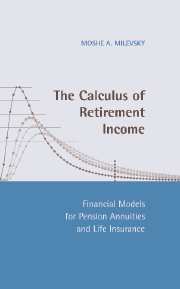Book contents
- Frontmatter
- Contents
- List of Figures and Tables
- I MODELS OF ACTUARIAL FINANCE
- 1 Introduction and Motivation
- 2 Modeling the Human Life Cycle
- 3 Models of Human Mortality
- 4 Valuation Models of Deterministic Interest
- 5 Models of Risky Financial Investments
- 6 Models of Pension Life Annuities
- 7 Models of Life Insurance
- 8 Models of DB vs. DC Pensions
- II WEALTH MANAGEMENT: APPLICATIONS AND IMPLICATIONS
- III ADVANCED TOPICS
- Bibliography
- Index
1 - Introduction and Motivation
from I - MODELS OF ACTUARIAL FINANCE
Published online by Cambridge University Press: 06 July 2010
- Frontmatter
- Contents
- List of Figures and Tables
- I MODELS OF ACTUARIAL FINANCE
- 1 Introduction and Motivation
- 2 Modeling the Human Life Cycle
- 3 Models of Human Mortality
- 4 Valuation Models of Deterministic Interest
- 5 Models of Risky Financial Investments
- 6 Models of Pension Life Annuities
- 7 Models of Life Insurance
- 8 Models of DB vs. DC Pensions
- II WEALTH MANAGEMENT: APPLICATIONS AND IMPLICATIONS
- III ADVANCED TOPICS
- Bibliography
- Index
Summary
The Drunk Gambler Problem
A few years ago I was asked to give a keynote lecture on the subject of retirement income planning to a group of financial advisors at an investment conference that was taking place in Las Vegas. I arrived at the conference venue early—as most neurotic speakers do—and while I was waiting to go on stage, I decided to wander around the nearby casino, taking in the sights, sounds, and smells of flashy cocktail waitresses, clanging coins, and musty cigars. Although I'm not a fan of gambling myself, I always enjoy watching others get excited about the mirage of a hot streak before eventually losing.
On this particular random walk around the roulette tables, I came across a rather eccentric-looking player smoking a particularly noxious cigar, though seemingly aloof and detached from the action around him. As I approached that particular table, I noticed two odd things about Jorge; a nickname I gave him. First, Jorge appeared to be using a very primitive gambling strategy. He was sitting in front of a large stack of red $5 chips, and on each spin of the wheel he would place one—and only one—of those $5 chips as a bet on the black portion of the table. For those of you who aren't familiar with roulette, this particular bet would double his money if the spinning ball landed on any one of the 18 black numbers, but it would cost him his bet if the ball came to a halt on any of the 18 red numbers or the occasional 2 green numbers.
- Type
- Chapter
- Information
- The Calculus of Retirement IncomeFinancial Models for Pension Annuities and Life Insurance, pp. 3 - 16Publisher: Cambridge University PressPrint publication year: 2006



